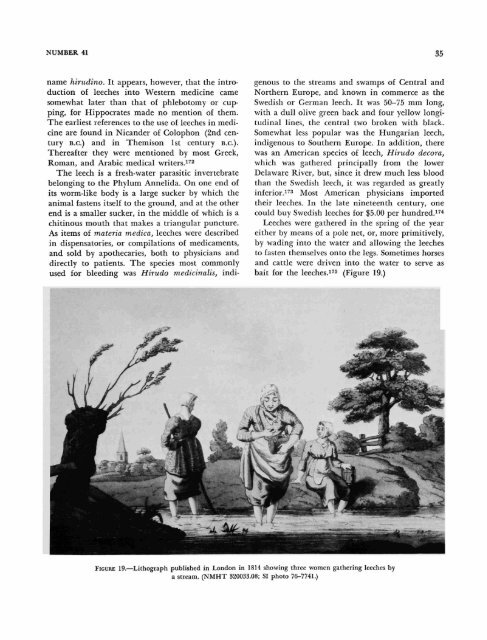BLOODLETTING INSTRUMENTS - Smithsonian Institution Libraries
BLOODLETTING INSTRUMENTS - Smithsonian Institution Libraries
BLOODLETTING INSTRUMENTS - Smithsonian Institution Libraries
You also want an ePaper? Increase the reach of your titles
YUMPU automatically turns print PDFs into web optimized ePapers that Google loves.
NUMBER 41 35<br />
name hirudino. It appears, however, that the introduction<br />
of leeches into Western medicine came<br />
somewhat later than that of phlebotomy or cupping,<br />
for Hippocrates made no mention of them.<br />
The earliest references to the use of leeches in medicine<br />
are found in Nicander of Colophon (2nd century<br />
B.C.) and in Themison 1st century B.C.).<br />
Thereafter they were mentioned by most Greek,<br />
Roman, and Arabic medical writers.i'^^<br />
The leech is a fresh-water parasitic invertebrate<br />
belonging to the Phylum Annelida. On one end of<br />
its worm-like body is a large sucker by which the<br />
animal fastens itself to the ground, and at the other<br />
end is a smaller sucker, in the middle of which is a<br />
chitinous mouth that makes a triangular puncture.<br />
As items of materia medica, leeches were described<br />
in dispensatories, or compilations of medicaments,<br />
and sold by apothecaries, both to physicians and<br />
directly to patients. The species most commonly<br />
used for bleeding was Hirudo medicinalis, indigenous<br />
to the streams and swamps of Central and<br />
Northern Europe, and known in commerce as the<br />
Swedish or German leech. It was 50-75 mm long,<br />
with a dull olive green back and four yellow longitudinal<br />
lines, the central two broken with black.<br />
Somewhat less popular was the Hungarian leech,<br />
indigenous to Southern Europe. In addition, there<br />
was an American species of leech, Hirudo decora,<br />
which was gathered principally from the lower<br />
Delaware River, but, since it drew much less blood<br />
than the Swedish leech, it was regarded as greatly<br />
inferior.i''^^ Most American physicians imported<br />
their leeches. In the late nineteenth century, one<br />
could buy Swedish leeches for $5.00 per hundred.i'^^<br />
Leeches were gathered in the spring of the year<br />
either by means of a pole net, or, more primitively,<br />
by wading into the water and allowing the leeches<br />
to fasten themselves onto the legs. Sometimes horses<br />
and cattle were driven into the water to serve as<br />
bait for the leeches.i^^ (Figure 19.)<br />
FIGURE 19.—Lithograph published in London in 1814 showing three women gathering leeches by<br />
a stream. (NMHT 320033.08; SI photo 76-7741.)
















